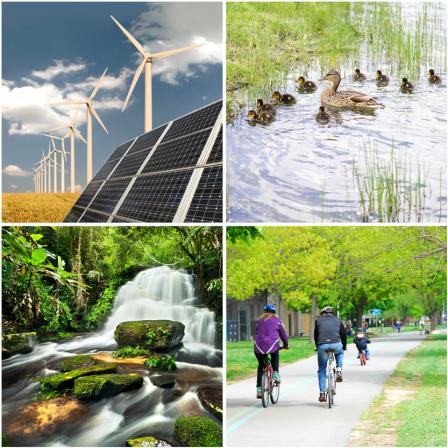Interactive Activities
 COVID-19 UPDATE:
COVID-19 UPDATE:
We've modified the following activities for presentation via remote platforms: Air Quality Overview, Building a Particulate Matter (PM) Sensor, GENERATE, Benefits of Trees, Connecting Ecosystems and Human Health, and Building a Greenway. They will have limited availability virtually through 2020. Please limit requests to two presentations per semester.
TOPIC AREAS
| Activity | Description | Duration | Audience | Max. Class Size | Presenters |
|---|---|---|---|---|---|
| Model combustion of fossil fuels to show how air pollution is created and climate impacted. | 20-45 minutes | Grades 3-10, Booth | 30 | Request a presenter for Air Chemistry with Legos | |
| Assemble and test a PM sensor with an Arduino circuit board, LED lights, PM sensor, and wiring. | 30-45 minutes | Grades 6-10, Booth | 20 | Request a presenter for Building a Particulate Matter (PM) Sensor | |
| Measure lung capacity and learn about air quality & health. Includes hypothesis testing, data collection & graphing. | 20-45 minutes | Grades K-12, Adults, Booth | 30 | Request a presenter for Lung Capacity | |
| Link sources of air particles using Scanning Electron Microscopes (SEM) photos. | 15-30 minutes | Grades 3-10, Booth | 20 | Request a presenter for Particle Matching | |
| Connect daily activities with air pollution; encourages students to think about ways to reduce air pollution in everyday life. | 25-40 minutes | Grades K-5 | 20 | Request a presenter for Whirling, Swirling Air Pollution | |
|
Air Quality Overview: Health, Sources, and Reducing Emissions |
Interactive presentation with hands-on activities: match air particles with their sources, measure lung capacity, and learn which household appliances use the most energy. | 45-60 minutes | Grades 3-12, Adults, Booth | 30 | Request a presenter for Air Quality Overview: Health, Sources, and Reducing Emissions |
| Activity | Description | Duration | Audience | Max. Class Size | Presenters |
|---|---|---|---|---|---|
| Use a board game to learn about costs & benefits of different types of fuel for electricity. Requires computer with PowerPoint/Excel and projector. | 60-90 minutes | Grades 6-12, Adults | 25 | Request a presenter for GENERATE: The Game of Energy Choices | |
| Urban Heat Islands | Measure surface and ambient temperatures in outdoor locations to learn how urban changes to the environment can affect temperature & human health. | 30-45 minutes | Grades 5-12, Adults | 20 | Request a presenter for Urban Heat Islands |
| Watts Up with Energy | Measure electricity consumption with Watts Meters. Older students can use math to calculate annual costs. A matching board version is available for limited time. | 15-45 minutes | Grades 3-12, Adults, Booth | 20 | Request a presenter for Watts Up with Energy |
| Activity | Description | Duration | Audience | Max. Class Size | Presenters |
|---|---|---|---|---|---|
| Use Jenga game to learn about food chains, food webs, and ecosystems in N.C. and how changes in the global environment can affect plants & animals in our ecosystems. | 30-45 minutes | Grades 4-8 | 25 | Request a presenter for Ecosystems Jenga | |
| Benefits of Trees | Measure the circumferences and find the annual economic value of a tree. The activity can include Goods from the Woods (products) and iNaturalist for tree identification. | 30-45 minutes | Grades 5-12, Adults | 30 | Request a presenter for Benefits of Trees |
| Activity | Description | Duration | Audience |
Max. Class Size |
Presenters |
|---|---|---|---|---|---|
| Use a group activity to understand the services that ecosystems provide and how these services provide health benefits to humans. | 30-45 minutes | Grades 3 - College |
Grades 3-8: 20 participants Grades 9-College: 30 participants |
Request a presenter for Connecting Ecosystems & Human Health | |
| Collaborate in small groups and engage in real-world decision-making using maps and data. | 60 minutes | Grades 9-12 | 30 | Request a presenter for Building a Greenway: A Case Study |
| Activity | Description | Duration | Audience | Max. Class Size | Presenters |
|---|---|---|---|---|---|
| Learn about macroinvertebrates as an indicator of water quality. | 30-45 minutes | Grades 3-12 | 30 | Request a presenter for Macroinvertebrates |
